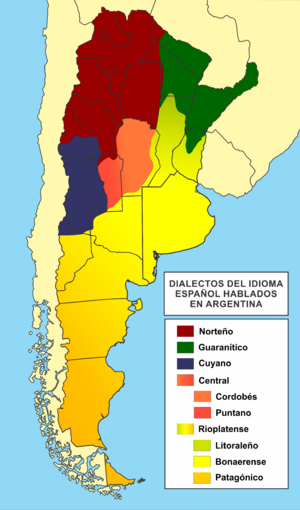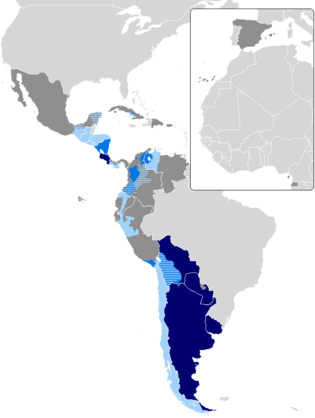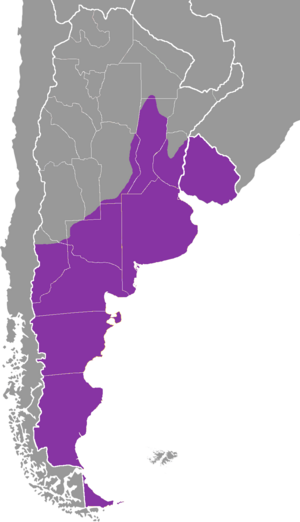Rioplatense Spanish facts for kids
Quick facts for kids Rioplatense Spanish |
||||
|---|---|---|---|---|
| Argentine–Uruguayan Spanish Español rioplatense (Español argentino-uruguayo) |
||||
| Pronunciation | [espaˈɲol ri.oplaˈtense] | |||
| Native to | Argentina, Uruguay | |||
| Ethnicity | Argentines Uruguayans |
|||
| Language family | ||||
| Early forms: |
Proto-Indo-European
|
|||
| Dialects | Outer Dialects: Norteño (Northern) Guaranítico (Northeastern) Cuyano (Western) Cordobés (Central) Inner Dialects: Litoraleño (Coastal) Bonaerense (Eastern) Patagónico (Southern) Uruguayan |
|||
| Writing system | Latin (Spanish alphabet) | |||
| Official status | ||||
| Official language in | ||||
| Regulated by | Academia Argentina de Letras Academia Nacional de Letras de Uruguay |
|||

Spanish dialects in Argentina
|
||||
|
||||
Rioplatense Spanish is a special way of speaking Spanish. It comes from the area around the Río de la Plata Basin, which is a big river system. Today, people speak it in most of Argentina and Uruguay.
One of the most interesting things about Rioplatense Spanish is that it uses the word vos instead of tú when talking to one person informally. It also has its own special verb endings for vos. Many parts of Rioplatense Spanish are also found in southern and eastern Bolivia and Paraguay. Sometimes, this way of speaking sounds a bit like the Neapolitan language from Southern Italy.
Rioplatense Spanish is a dialect, not a separate language. This means it's a specific version of Spanish. About 25 to 30 million people speak it.
Contents
Where Rioplatense Spanish is Spoken
Rioplatense Spanish is mostly spoken in big cities in Argentina like Buenos Aires, Rosario, Santa Fe, La Plata, Mar del Plata, and Bahía Blanca. It's also spoken in all of Uruguay.
Even in areas not directly next to these cities, like parts of Paraguay, all of Patagonia, and southern Córdoba, you'll hear Rioplatense Spanish. It's the standard way of speaking on TV and radio in Argentina and Uruguay. In northeastern Uruguay, there's even a mix of Portuguese and Rioplatense Spanish called Riverense Portuñol. About 70% of Argentinians speak with this accent.
How Rioplatense Spanish Developed
The Spanish language arrived in this region when the Spanish colonized the Americas. The Río de la Plata area was first part of the Viceroyalty of Peru. Later, in 1776, it became its own important area called the Viceroyalty of the Río de la Plata.
Before many people started moving to the region in the 1870s, the Spanish spoken here didn't have much influence from other languages. It mainly had local words. Argentinians and Uruguayans often say that their populations, like those in the United States and Canada, have many people who came from Europe more recently. The biggest groups of immigrants were from Italy and Spain.
European Immigration's Impact
Many different languages, especially Italian, changed the local Spanish spoken by the criollo people. This happened because so many different settlers and immigrants came to Argentina and Uruguay:
- From 1870 to 1890: Most immigrants were from Northern Italy, Spain, and areas speaking Basque and Galician. Some also came from France, Germany, and other European countries.
- From 1910 to 1945: More people arrived from Spain, Southern Italy, and Portugal. Smaller numbers came from other parts of Europe. Many Jewish immigrants, mainly from the Russian Empire and Poland, also arrived from the 1910s until after World War II.
- People who spoke English, from Britain and Ireland, were not as many, but they were still a significant group.
Native Language Influence
European settlement greatly reduced the number of Native American people before 1810 and during the expansion into Patagonia after 1870. However, Spanish mixed with several native languages, leaving some words behind. Words from Guarani, Quechua, and other native languages became part of the local Spanish.
Here are some words from Native American languages often used in Rioplatense Spanish:
- From Quechua:
- guacho or guacha (originally wakcha, meaning "poor person, wanderer, orphan"). The word for the native cowboys of the Pampas, gaucho, might be related.
- choclo or pochoclo (from choqllo, meaning corn) is used for popcorn in Argentina.
- From Guaraní: pororó is used for popcorn in Uruguay, Paraguay, and some Argentine provinces.
How Rioplatense Spanish Sounds
Special Pronunciations
Rioplatense Spanish has some unique ways of saying certain sounds:
- The "sh" sound: In Rioplatense, the sounds for ll (like in llama) and y (like in yo) are pronounced the same. This is called yeísmo. But in Rioplatense, this combined sound is often pronounced like the "sh" in "shine" (this is called sheísmo). So, yo (I) sounds like "sho." This "sh" sound started in Buenos Aires but is now common in Argentina and Uruguay.
- The "s" sound: Like in many other Spanish dialects, Rioplatense Spanish does not distinguish between the "s" sound and the "th" sound (like in "think"). This is called seseo. So, casa (house) and caza (hunt) sound the same.
- Soft "s" sound: When an "s" comes before another consonant or at the end of a word, it often becomes a soft "h" sound. For example, esto es lo mismo (this is the same) might sound like "ehto eh lo mihmo."
- Dropping sounds: In some areas, especially in fast speech, people might drop the "r" sound at the end of verbs (like in comer) or the "s" sound at the end of many words.
Speaking Rhythm
Studies show that Rioplatense Spanish, especially in Buenos Aires, has a rhythm that sounds like Italian dialects. This makes sense because many Italian immigrants came to Argentina and Uruguay starting in the 1800s. Researchers found that people in Buenos Aires and Rosario speak with an intonation that is very similar to Neapolitan.
Using "Vos" and Other Pronouns

One of the most famous features of Argentine and Uruguayan Spanish is the use of voseo. This means using the pronoun vos instead of tú for "you" (singular, informal). In other Spanish-speaking places, voseo might be seen as less formal, but in Argentina and Uruguay, it's completely normal and standard.
For talking to more than one person, Rioplatense Spanish uses ustedes instead of vosotros (which is used in Spain). Ustedes is used for both formal and informal situations, like talking to friends or teachers. When you use ustedes, the verb acts like you are talking about "they."
Let's look at how the verb amar (to love) changes with vos:
| Person/Number | Spain Spanish | Rioplatense Spanish |
|---|---|---|
| I | yo amo | yo amo |
| You (singular, informal) | tú amas | vos amás |
| He/She/It | él ama | él ama |
| We | nosotros amamos | nosotros amamos |
| You (plural) | vosotros amáis | ustedes aman |
| They | ellos aman | ellos aman |
Notice that with vos, the stress moves to the last syllable, and the ending changes slightly (like amás instead of amas). For verbs like perder (to lose), the vowel in the middle of the word can also change:
| Spain Spanish | Rioplatense Spanish |
|---|---|
| yo pierdo | yo pierdo |
| tú pierdes | vos perdés |
| él pierde | él pierde |
| nosotros perdemos | nosotros perdemos |
| vosotros perdéis | ustedes pierden |
| ellos pierden | ellos pierden |
For verbs ending in -ir, the vos form is often the same as the vosotros form from Spain, but without the "i" at the end. For example, instead of tú vives (you live), it's vos vivís.
Giving Commands (Imperative)
When you give a command using vos, the verb usually stresses the last syllable:
- Hablá más fuerte, por favor. ("Speak louder, please.") (In Spain, it's habla).
- Comé un poco de torta. ("Eat some cake.") (In Spain, it's come).
For commands like "come here" or "do it," the verb ir (to go) is usually replaced with a form of andar (to walk, to go):
- Andá para allá. ("Go there.") (In Spain, it's ve).
For commands to a group of people, the ustedes form is used.
How Tenses Are Used
In everyday Rioplatense Spanish, people often use a phrase with the verb ir (to go) to talk about the future, instead of the simple future tense. It's like saying "going to" in English.
- Creo que voy a descansar un poco. (I think I am going to rest a little.) Instead of Creo que descansaré un poco. (I think I will rest a little.)
Also, the "present perfect" tense (like "has arrived") is not used much. Instead, people use the simple past tense.
- Juan no llegó todavía. (Juan did not arrive yet.) Instead of Juan no ha llegado todavía. (Juan has not arrived yet.)
However, in certain situations, like when you're talking about something you're not sure about (the subjunctive mood), the present perfect is still used:
- No creo que lo hayan visto ya. (I don't believe they have already seen him.)
Rioplatense Spanish Beyond Argentina
Rioplatense Spanish has influenced the way people speak in Chile. Even though Chileans might not always admit it, many words from Argentina have become part of their language. This happens because of tourism and watching Argentine TV shows. Chilean Spanish often adopts words from Argentina, but it's less common for Argentine Spanish to adopt words from Chile.
Some Argentine words have even made it into Spanish spoken in Spain. For example, pibe and piba (meaning "boy" and "girl") are now used in Spanish slang.
See also
 In Spanish: Español rioplatense para niños
In Spanish: Español rioplatense para niños
- Immigration to Argentina
- Lunfardo, a special slang from Buenos Aires
- Vesre, a fun way of speaking by reversing syllables in words
- Voseo


